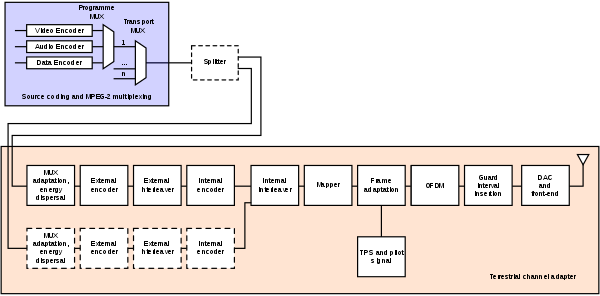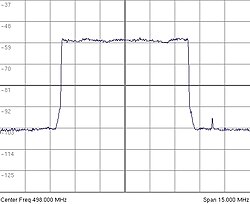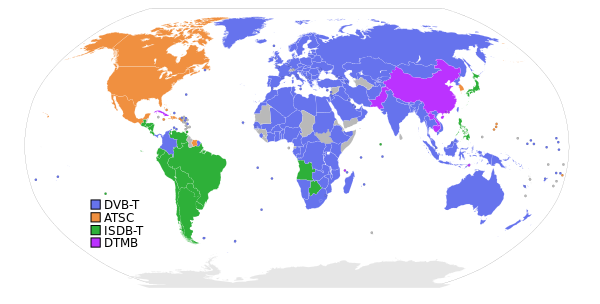DVB-T: Difference between revisions
Cantalamessa (talk | contribs) |
|||
| Line 13: | Line 13: | ||
DVB-T has been further developed into newer standards such as [[DVB-H]] (Handheld), now in operation, and [[DVB-T2]], which was recently finalised. |
DVB-T has been further developed into newer standards such as [[DVB-H]] (Handheld), now in operation, and [[DVB-T2]], which was recently finalised. |
||
DVB-T as a digital transmission delivers data in a series of discrete blocks at the clock or symbol rate. DVB-T includes a "Guard Interval" feature where the receiver ignores the data for a short period around the time when the data changes. Within limits, this allows for the receiver to ignore the effects of [[multipath]] reception. Within a geographical area, use of the guard interval also allows [[single-frequency network]] (SFN) operation, where two or more transmitters carrying the '''same''' transport stream of services can operate on the same RF channel frequency. In such cases the signals from each transmitter in the SFN needs to be accurately time-aligned, which is usually done by a sync signal in the stream and [[GPS]] timing at each transmission point. This allows the overlap region between transmitters, sometimes called the 'mush zone', to be geographically shifted away from population centers. |
|||
== Technical description of a DVB-T transmitter == |
== Technical description of a DVB-T transmitter == |
||
Revision as of 22:23, 3 December 2008
| List of digital television broadcast standards |
|---|
| DVB standards (countries) |
| ATSC standards (countries) |
|
| ISDB standards (countries) |
| DTMB standards (countries) |
| DMB standard (countries) |
| Codecs |
|
| Terrestrial Frequency bands |
| Satellite Frequency bands |
DVB-T is an abbreviation for Digital Video Broadcasting – Terrestrial; it is the DVB European-based consortium standard for the broadcast transmission of digital terrestrial television. This system transmits compressed digital audio, video and other data in an MPEG transport stream, using COFDM modulation.
Basics of DVB-T
Rather than carrying the data on a single radio frequency carrier, OFDM works by splitting the digital data stream into a large number of slower digital streams, each of which digitally modulate a set of closely spaced adjacent carrier frequencies. In the case of DVB-T, there are two choices for the number of carriers known as 2K-mode or 8K-mode. These are actually 1705 or 6817 carriers that are approximately 4 kHz or 1 kHz apart.
DVB-T offers three different modulation schemes (QPSK, 16QAM, 64QAM).
DVB-T has been adopted or proposed for digital television broadcasting by many countries (see map), using mainly VHF 7 MHz and UHF 8 MHz channels whereas Taiwan uses 6 MHz channels. Examples include the UK's Freeview.
The DVB-T Standard is published as EN 300 744, Framing structure, channel coding and modulation for digital terrestrial television. This is available from the ETSI website, as is ETSI TS 101 154, Specification for the use of Video and Audio Coding in Broadcasting Applications based on the MPEG-2 Transport Stream, which gives details of the DVB use of source coding methods for MPEG-2 and, more recently, H.264/MPEG-4 AVC as well as audio encoding systems. Many counties that have adopted DVB-T have published standards for their implementation. These include the D-Book in the UK, the Italian DGTVi [1], the ETSI E-Book and Scandivia NorDig.
DVB-T has been further developed into newer standards such as DVB-H (Handheld), now in operation, and DVB-T2, which was recently finalised.
Technical description of a DVB-T transmitter

With reference to the figure, a short description of the signal processing blocks follows.
- Source coding and MPEG-2 multiplexing (MUX): compressed video, compressed audio, and data streams are multiplexed into PSs (Programme Streams). One or more PSs are joined together into an MPEG-2 TS (MPEG-2 Transport Stream); this is the basic digital stream which is being transmitted and received by home Set Top Boxes (STB). Allowed bitrates for the transported data depend on a number of coding and modulation parameters: it can range from about 5 to about 32 Mbit/s (see the bottom figure for a complete listing).
- Splitter: two different TSs can be transmitted at the same time, using a technique called Hierarchical Transmission. It may be used to transmit, for example, a standard definition SDTV signal and a high definition HDTV signal on the same carrier. Generally, the SDTV signal is more robust than the HDTV one. At the receiver, depending on the quality of the received signal, the STB may be able to decode the HDTV stream or, if signal strength lacks, it can switch to the SDTV one (in this way, all receivers that are in proximity of the transmission site can lock the HDTV signal, whereas all the other ones, even the farthest, may still be able to receive and decode an SDTV signal).
- MUX adaptation and energy dispersal: the MPEG-2 TS is identified as a sequence of data packets, of fixed length (188 bytes). With a technique called energy dispersal, the byte sequence is decorrelated.
- External encoder: a first level of error correction is applied to the transmitted data, using a nonbinary block code, a Reed-Solomon RS (204, 188) code, allowing the correction of up to a maximum of 8 wrong bytes for each 188-byte packet.
- External interleaver: convolutional interleaving is used to rearrange the transmitted data sequence, in such a way that it becomes more rugged to long sequences of errors.
- Internal encoder: a second level of error correction is given by a punctured convolutional code, which is often denoted in STBs menus as FEC (Forward error correction). There are five valid coding rates: 1/2, 2/3, 3/4, 5/6, and 7/8.
- Internal interleaver: data sequence is rearranged again, aiming to reduce the influence of burst errors. This time, a block interleaving technique is adopted, with a pseudo-random assignment scheme (this is really done by two separate interleaving processes, one operating on bits and another one operating on groups of bits).
- Mapper: the digital bit sequence is mapped into a base band modulated sequence of complex symbols. There are three valid modulation schemes: QPSK, 16-QAM, 64-QAM.
- Frame adaptation: the complex symbols are grouped in blocks of constant length (1512, 3024, or 6048 symbols per block). A frame is generated, 68 blocks long, and a superframe is built by 4 frames.
- Pilot and TPS signals: in order to simplify the reception of the signal being transmitted on the terrestrial radio channel, additional signals are inserted in each block. Pilot signals are used during the synchronization and equalization phase, while TPS signals (Transmission Parameters Signalling) send the parameters of the transmitted signal and to unequivocally identify the transmission cell. The receiver must be able to synchronize, equalize, and decode the signal to gain access to the information held by the TPS pilots. Thus, the receiver must know this information beforehand, and the TPS data is only used in special cases, such as changes in the parameters, resynchronizations, etc.

- OFDM Modulation: the sequence of blocks is modulated according to the OFDM technique, using 2048, 4096, or 8192 carriers (2k, 4k, 8k mode, respectively). Increasing the number of carriers does not modify the payload bit rate, which remains constant.
- Guard interval insertion: to decrease receiver complexity, every OFDM block is extended, copying in front of it its own end (cyclic prefix). The width of such guard interval can be 1/32, 1/16, 1/8, or 1/4 that of the original block length. Cyclic prefix is required to operate single frequency networks, where there may exist an ineliminable interference coming from several sites transmitting the same program on the same carrier frequency.
- DAC and front-end: the digital signal is transformed into an analog signal, with a digital-to-analog converter (DAC), and then modulated to radio frequency (VHF, UHF) by the RF front-end. The occupied bandwidth is designed to accommodate each single DVB-T signal into 5, 6, 7, or 8 MHz wide channels. The base band sample rate provided at the DAC input depends on the channel bandwidth: it is samples/s, where is the channel bandwidth expressed in Hz.
| Available bitrates (Mbit/s) for a DVB-T system in 8 MHz channels | |||||
|---|---|---|---|---|---|
| Modulation | Coding rate | Guard interval | |||
| 1/4 | 1/8 | 1/16 | 1/32 | ||
| QPSK | 1/2 | 4.976 | 5.529 | 5.855 | 6.032 |
| 2/3 | 6.635 | 7.373 | 7.806 | 8.043 | |
| 3/4 | 7.465 | 8.294 | 8.782 | 9.048 | |
| 5/6 | 8.294 | 9.216 | 9.758 | 10.053 | |
| 7/8 | 8.709 | 9.676 | 10.246 | 10.556 | |
| 16-QAM | 1/2 | 9.953 | 11.059 | 11.709 | 12.064 |
| 2/3 | 13.271 | 14.745 | 15.612 | 16.086 | |
| 3/4 | 14.929 | 16.588 | 17.564 | 18.096 | |
| 5/6 | 16.588 | 18.431 | 19.516 | 20.107 | |
| 7/8 | 17.418 | 19.353 | 20.491 | 21.112 | |
| 64-QAM | 1/2 | 14.929 | 16.588 | 17.564 | 18.096 |
| 2/3 | 19.906 | 22.118 | 23.419 | 24.128 | |
| 3/4 | 22.394 | 24.882 | 26.346 | 27.144 | |
| 5/6 | 24.882 | 27.647 | 29.273 | 30.160 | |
| 7/8 | 26.126 | 29.029 | 30.737 | 31.668 | |
Technical description of the receiver
The receiving STB adopts techniques which are dual to those ones used in the transmission.
- Front-end and ADC: the analog RF signal is converted to base-band and transformed into a digital signal, using an analog-to-digital converter (ADC).
- Time and frequency synchronization: the digital base band signal is searched to identify the beginning of frames and blocks. Any problems with the frequency of the components of the signal are corrected, too. The property that the guard interval at the end of the symbol is placed also at the beginning is exploited to find the beginning of a new OFDM symbol. On the other hand, continual pilots (whose value and position is determined in the standard and thus known by the receiver) determine the frequency offset suffered by the signal. This frequency offset might have been caused by Doppler effect, inaccuracies in either the transmitter or receiver clock, and so on.
- Guard interval disposal: the cyclic prefix is removed.
- OFDM demodulation
- Frequency equalization: the pilot signals equalize the received signal.
- Demapping
- Internal deinterleaving
- Internal decoding: uses the Viterbi algorithm.
- External deinterleaving
- External decoding
- MUX adaptation
- MPEG-2 demultiplexing and source decoding
Countries and territories using DVB-T[2]

Americas
 Argentina (experimental)
Argentina (experimental) Colombia (decided in August 28, 2008) [3]
Colombia (decided in August 28, 2008) [3] Uruguay (decided in September 2007, but not effective yet)
Uruguay (decided in September 2007, but not effective yet)
Europe
 Albania
Albania Andorra
Andorra Austria
Austria Belgium
Belgium Bulgaria (experimental)
Bulgaria (experimental) Belarus (experimental)
Belarus (experimental) Croatia See DVB-T in Croatia.)
Croatia See DVB-T in Croatia.) Czech Republic
Czech Republic Cyprus
Cyprus Denmark (See DVB-T in Denmark.)
Denmark (See DVB-T in Denmark.)
 Estonia (uses MPEG-4 video)
Estonia (uses MPEG-4 video) Finland
Finland France (uses MPEG-2 for SD and MPEG-4 for HD transmissions.)
France (uses MPEG-2 for SD and MPEG-4 for HD transmissions.) Germany
Germany Greece
Greece
 Hungary (start at December 1st, 2008, branded MindigTV, SD & HD transmissions uses MPEG-4 video.)
Hungary (start at December 1st, 2008, branded MindigTV, SD & HD transmissions uses MPEG-4 video.) Iceland[citation needed]
Iceland[citation needed] Ireland (Will use MPEG-4 video, see DVB-T in Ireland.)
Ireland (Will use MPEG-4 video, see DVB-T in Ireland.) Italy
Italy Latvia (experimental)
Latvia (experimental) Lithuania
Lithuania Luxembourg
Luxembourg- Template:Country data Former Yugoslav Republic of Macedonia
 Malta
Malta Montenegro
Montenegro Netherlands
Netherlands Norway (uses MPEG-4 video)
Norway (uses MPEG-4 video) Poland (experimental, uses MPEG-4 video)
Poland (experimental, uses MPEG-4 video) Portugal
Portugal Romania
Romania Russia (experimental)
Russia (experimental) Slovakia (experimental)
Slovakia (experimental) Serbia
Serbia Slovenia (See DVB-T in Slovenia)
Slovenia (See DVB-T in Slovenia) Spain
Spain Sweden (See DVB-T in Sweden.)
Sweden (See DVB-T in Sweden.) Switzerland
Switzerland Turkey (experimental)
Turkey (experimental) United Kingdom (See DVB-T in United Kingdom.)
United Kingdom (See DVB-T in United Kingdom.) Ukraine (experimental, Kyiv only, 20 channels)
Ukraine (experimental, Kyiv only, 20 channels)
Asia/Australasia
 Australia
Australia India (Uses MPEG-4 and MPEG-2 Video)
India (Uses MPEG-4 and MPEG-2 Video) Indonesia
Indonesia Iran (pilot service)
Iran (pilot service) Israel
Israel Malaysia (experimental)
Malaysia (experimental) Myanmar
Myanmar New Zealand (see Freeview)
New Zealand (see Freeview) Philippines (experimental)
Philippines (experimental) Singapore
Singapore Saudi Arabia
Saudi Arabia Sri Lanka (pilot service [4])
Sri Lanka (pilot service [4]) Taiwan
Taiwan Thailand
Thailand Vietnam
Vietnam United Arab Emirates
United Arab Emirates
Africa
See also
- ATSC (Advanced Television Systems Committee, North American Standard)
- Digital audio broadcasting (low bitrate video suitable for moving receivers)
- DTV channel protection ratios
- DVB over IP
- Interactive television
- Digital terrestrial television
- DMB-T - Digital Multimedia Broadcast-Terrestrial
- ISDB - Integrated Services Digital Broadcasting
- OFDM system comparison table
- Spectral efficiency comparison table
Notes
- ^ "DGTVi - Per la Televisione Digitale Terrestre".
- ^ Official information taken from the DVB website
- ^ El Espectador, Colombia adopta el estándar europeo para la tv digital terrestre, 28 August 2008
- ^ Lankanewspapers.com, Dialog TV launches another South Asia`s first DVBT, 2008-01-24. Retrieved on 2008-01-26.
References
- ETSI Standard: EN 300 744 V1.5.1, Digital Video Broadcasting (DVB); Framing structure, channel coding and modulation for digital terrestrial television, available at ETSI Publications Download Area (This will open ETSI document search engine, to find the latest version of the document enter a search string; free registration is required to download PDF.)


